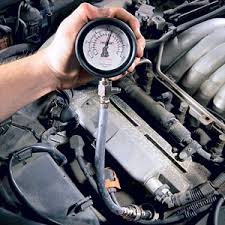Mercruiser Gasoline Engine Compression Test
Models
All Mercruiser Sterndrive and Inboard Gasoline Marine Engines.
New Compression Pressure
Compression Pressure 100 psi (690 kPa) Minimum (1)
(1) Minimum compression recorded in any one cylinder should not be less than 70% of the highest recorded cylinder.
Gasoline Engine Compression Test
A. With the engine at normal room temperature, ground the ignition coil wire (that goes to the distributor cap) directly to engine ground stud and remove all spark plugs.
IMPORTANT: Ground the ignition coil wire (that goes to the distributor cap) directly to engine ground stud to prevent a possibility of a spark from the disconnected spark plug wires. When using a Remote Starter tool to crank the engine over, some engines may have the ignition coil energized by the ‘R’ terminal in the starter solenoid even though the key switch and the Lanyard Stop Switch is in the ‘off’ position.
- Use a fully charged battery.
- Open throttle plate completely.
- Starting with the compression gauge at ‘0’, crank the engine through 4 compression strokes (4 ‘puffs’).
- Record compression for each cylinder.
- If some cylinders have low compression, use a pump type oil can to inject 3 squirts of oil into each combustion chamber through the spark plug hole. Do second compression check on each cylinder.
- No cylinder should read less than 100 psi (690 kPa).
- Compression recorded on any one cylinder should not be less than 70% of the highest cylinder. Example: If the highest cylinder has 150 psi (1035 kPa), the lowest allowable pressure for any other cylinder would be 105 psi (725 kPa). [150 X 70% = 105 psi (1035 X 70% = 725 kPa)].
- a) Normal: Compression builds up quickly and evenly in each cylinder.
b) Piston Rings Leaking: Compression low on first stroke then increases on following strokes but does not reach normal. Compression improves considerably with 3 squirts of oil.
c) Valves Leaking: Compression low on first stroke and does not build up on following strokes or with 3 squirts of oil.
d) If 2 Adjacent Cylinders Have Lower Than Normal Compression: Inject 3 squirts of oil into the cylinders. If the compression does not increase, the cause may be a blown head gasket between cylinders.
Using Air to Test Engine’s Combustion Chamber
If a low cylinder is found during the compression test, the use of air pressure can help you find out if the engine has a valve or piston problem.
- Open throttle plates completely.
- With spark plugs still removed, rotate the engine until number 1 piston is at TDC on the compression stroke. This will ensure that both valves are closed.
- Rotate the crankshaft the exact number of degrees specified to put the next cylinder in the firing order at TDC.
- 4 cylinder=180 degrees.
- V6=120 degrees.
- V8=90 degrees.
NOTE: If you want to test just the cylinder with low compression, find it’s position in the firing order. Rotate the crankshaft the same number of degree increments as that cylinder is from number 1 cylinder in the firing order. Example: V6 with 1-6-5-4-3-2 firing order. Number 4 is the cylinder that you want to test. It is the third increment from number 1 cylinder TDC. Rotate crankshaft three 120 degree increments to bring number 4 cylinder to TDC on its compression stroke.
- Hold crankshaft balancer bolt with large wrench to prevent engine’s crankshaft from rotating when applying air pressure to the cylinder.
- Use a compression gauge style air adaptor hose to thread into the spark plug hole.
- Using an air hose, apply 20-30 psi (138-206 kPa) air pressure through this adaptor hose into the cylinder to be tested. Make sure crankshaft does not rotate.
- a) If air can be heard coming out of the throttle plates, the intake valve may be leaking.
- b) If air can be heard coming out of the exhaust, the exhaust valve may be leaking.
- c) If a large amount of air can be heard or felt coming out of the oil fill cap in the rocker arm cover, the piston or piston rings may be leaking. A small amount of air will leak past the piston rings in this test.

